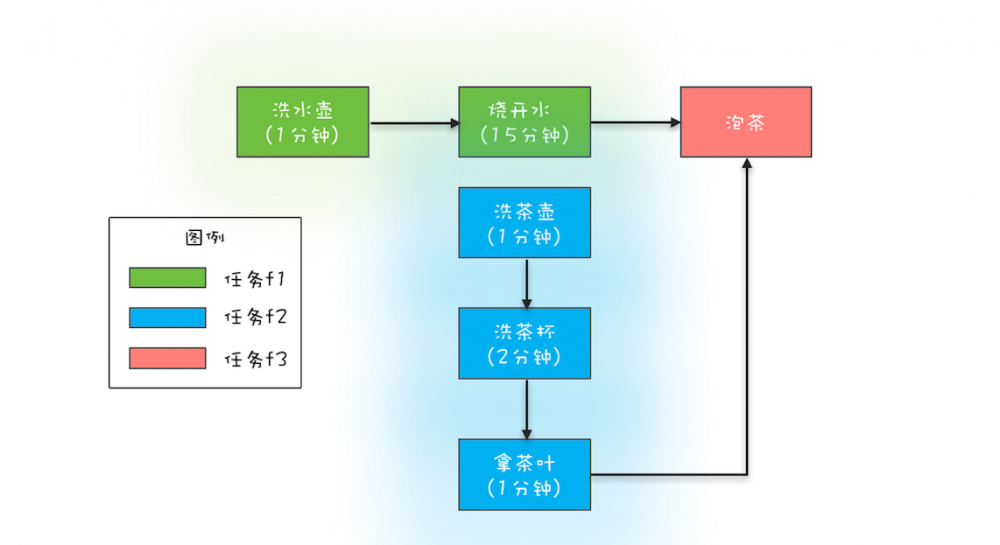Java并发 -- CompletableFuture

CompletableFuture<Void> f1 = CompletableFuture.runAsync(() -> {
System.out.println("T1: 洗水壶");
sleep(1, TimeUnit.SECONDS);
System.out.println("T1: 烧开水");
sleep(15, TimeUnit.SECONDS);
});
CompletableFuture<String> f2 = CompletableFuture.supplyAsync(() -> {
System.out.println("T2: 洗茶壶");
sleep(1, TimeUnit.SECONDS);
System.out.println("T2: 洗茶杯");
sleep(2, TimeUnit.SECONDS);
System.out.println("T2: 拿茶叶");
sleep(1, TimeUnit.SECONDS);
return "龙井";
});
CompletableFuture<String> f3 = f1.thenCombine(f2, (__, tea) -> {
System.out.println("T3: 拿到茶叶: " + tea);
System.out.println("T3: 泡茶");
return "上茶: " + tea;
});
System.out.println(f3.join());
创建CompletableFuture对象
// 默认线程池,采用公共的ForkJoinPool线程池,线程数为CPU核数 // 如果所有的CompletableFuture共享同一个线程池,一旦有任务有慢IO操作,会导致其他线程饥饿,影响系统性能 // 所以,应该根据不同的业务类型创建不同的线程池,避免相互干扰 public static CompletableFuture<Void> runAsync(Runnable runnable); // Runnable.run没有返回值,Supplier.get有返回值 public static <U> CompletableFuture<U> supplyAsync(Supplier<U> supplier); // 指定线程池 public static CompletableFuture<Void> runAsync(Runnable runnable, Executor executor); public static <U> CompletableFuture<U> supplyAsync(Supplier<U> supplier, Executor executor); // 创建完CompletableFuture对象之后,会自动地异步执行Runnable.run或者Supplier.get
CompletionStage
// CompletionStage接口可以清晰地描述任务之间的时序关系,例如串行关系、并行关系和汇聚关系(AND、OR)等 // CompletionStage接口也可以方便地描述异常处理 public class CompletableFuture<T> implements Future<T>, CompletionStage<T>
串行关系
public <U> CompletableFuture<U> thenApply(Function<? super T,? extends U> fn); public <U> CompletionStage<U> thenApplyAsync(Function<? super T,? extends U> fn); public <U> CompletionStage<U> thenApplyAsync(Function<? super T,? extends U> fn, Executor executor); public CompletableFuture<Void> thenAccept(Consumer<? super T> action); public CompletionStage<Void> thenAcceptAsync(Consumer<? super T> action); public CompletionStage<Void> thenAcceptAsync(Consumer<? super T> action, Executor executor); public CompletableFuture<Void> thenRun(Runnable action); public CompletionStage<Void> thenRunAsync(Runnable action); public CompletionStage<Void> thenRunAsync(Runnable action, Executor executor); // 新建一个子流程,最终结果与thenApply相同 public <U> CompletableFuture<U> thenCompose(Function<? super T, ? extends CompletionStage<U>> fn); public <U> CompletionStage<U> thenComposeAsync(Function<? super T, ? extends CompletionStage<U>> fn); public <U> CompletionStage<U> thenComposeAsync(Function<? super T, ? extends CompletionStage<U>> fn, Executor executor);
// supplyAsync会启动一个异步流程,步骤1、2、3是串行执行的
CompletableFuture<String> f = CompletableFuture
.supplyAsync(() -> "Hello World") // 1
.thenApply(s -> s + " QQ") // 2
.thenApply(String::toUpperCase); // 3
System.out.println(f.join()); // HELLO WORLD QQ
AND 汇聚关系
public <U,V> CompletionStage<V> thenCombine (CompletionStage<? extends U> other, BiFunction<? super T,? super U,? extends V> fn); public <U,V> CompletionStage<V> thenCombineAsync(CompletionStage<? extends U> other, BiFunction<? super T,? super U,? extends V> fn); public <U,V> CompletionStage<V> thenCombineAsync(CompletionStage<? extends U> other, BiFunction<? super T,? super U,? extends V> fn, Executor executor); public <U> CompletionStage<Void> thenAcceptBoth(CompletionStage<? extends U> other, BiConsumer<? super T, ? super U> action); public <U> CompletionStage<Void> thenAcceptBothAsync(CompletionStage<? extends U> other, BiConsumer<? super T, ? super U> action); public <U> CompletionStage<Void> thenAcceptBothAsync(CompletionStage<? extends U> other, BiConsumer<? super T, ? super U> action, Executor executor); public CompletionStage<Void> runAfterBoth(CompletionStage<?> other, Runnable action); public CompletionStage<Void> runAfterBothAsync(CompletionStage<?> other, Runnable action); public CompletionStage<Void> runAfterBothAsync(CompletionStage<?> other, Runnable action, Executor executor);
OR 汇聚关系
public <U> CompletionStage<U> applyToEither(CompletionStage<? extends T> other, Function<? super T, U> fn); public <U> CompletionStage<U> applyToEitherAsync(CompletionStage<? extends T> other, Function<? super T, U> fn); public <U> CompletionStage<U> applyToEitherAsync(CompletionStage<? extends T> other, Function<? super T, U> fn, Executor executor); public CompletionStage<Void> acceptEither(CompletionStage<? extends T> other, Consumer<? super T> action); public CompletionStage<Void> acceptEitherAsync(CompletionStage<? extends T> other, Consumer<? super T> action); public CompletionStage<Void> acceptEitherAsync(CompletionStage<? extends T> other, Consumer<? super T> action, Executor executor); public CompletionStage<Void> runAfterEither(CompletionStage<?> other, Runnable action); public CompletionStage<Void> runAfterEitherAsync(CompletionStage<?> other, Runnable action); public CompletionStage<Void> runAfterEitherAsync(CompletionStage<?> other, Runnable action, Executor executor);
CompletableFuture<String> f1 = CompletableFuture.supplyAsync(() -> {
int t = getRandom();
System.out.println("f1 need " + t);
sleep(t, TimeUnit.SECONDS);
System.out.println("f1 done");
return "f1 takes " + String.valueOf(t);
});
CompletableFuture<String> f2 = CompletableFuture.supplyAsync(() -> {
int t = getRandom();
System.out.println("f2 need " + t);
sleep(t, TimeUnit.SECONDS);
System.out.println("f2 done");
return "f2 takes " + String.valueOf(t);
});
CompletableFuture<String> f3 = f1.applyToEither(f2, s -> s);
f3.join();
// f1 need 9
// f2 need 1
// f2 done
异常处理
public CompletionStage<T> exceptionally(Function<Throwable, ? extends T> fn); public CompletionStage<T> whenComplete(BiConsumer<? super T, ? super Throwable> action); public CompletionStage<T> whenCompleteAsync(BiConsumer<? super T, ? super Throwable> action); public CompletionStage<T> whenCompleteAsync(BiConsumer<? super T, ? super Throwable> action, Executor executor); public <U> CompletionStage<U> handle(BiFunction<? super T, Throwable, ? extends U> fn); public <U> CompletionStage<U> handleAsync(BiFunction<? super T, Throwable, ? extends U> fn); public <U> CompletionStage<U> handleAsync(BiFunction<? super T, Throwable, ? extends U> fn, Executor executor);
CompletableFuture<Integer> f = CompletableFuture
.supplyAsync(() -> 1 / 0)
.thenApply(i -> i * 10)
.exceptionally(t -> 0) // 类似于catch{}
.whenComplete((i, t) -> { // 类似于finally,whenComplete不支持返回结果,handle支持返回结果
});
System.out.println(f.join()); // 0
转载请注明出处:http://zhongmingmao.me/2019/05/15/java-concurrent-completable-future/
访问原文「 Java并发 -- CompletableFuture 」获取最佳阅读体验并参与讨论
正文到此结束
热门推荐
相关文章
Loading...










![[HBLOG]公众号](https://www.liuhaihua.cn/img/qrcode_gzh.jpg)

